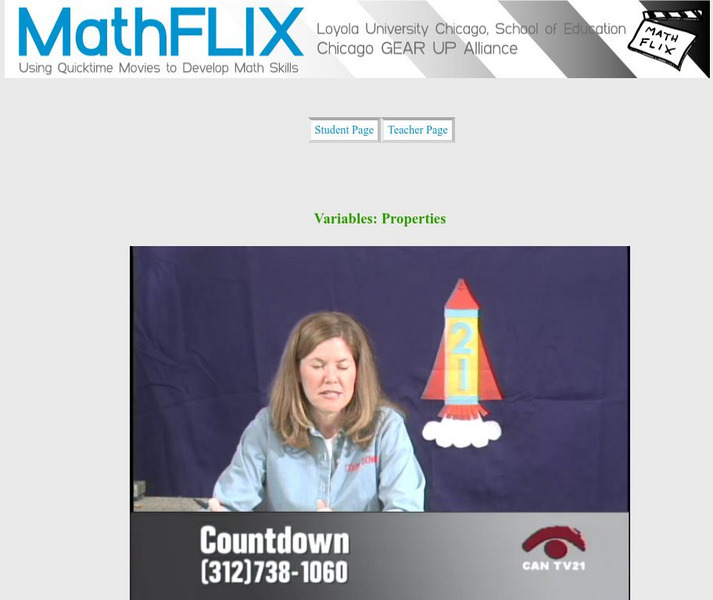Annenberg Foundation
Annenberg Learner: Against All Odds: Measures of Center
It's helpful to know the center of a distribution, which is what the clerical workers in Colorado Springs found out in the 1980s when they campaigned for comparable wages for comparable work. Mean and median are two different ways to...
Sophia Learning
Sophia: Stable vs. Unstable
A narrated screencast explains the concept of stability in objects. [3:16]
Loyola University Chicago
Math Flix: Variables: Properties
This QuickTime movie provides excellent explanations of the Distributive, Commutative, and Associative Properties using variables with examples. As you watch and listen to the teacher and student interact it helps clarify the thinking...
Loyola University Chicago
Math Flix: Variables and the Distributive Property
This QuickTime movie provides an excellent explanation of the Distributive Property using variables with examples. As you watch and listen to the teacher and student interact it helps clarify the thinking behind applying this concept.
Incorporated Research Institutions for Seismology
Iris: Basin & Range: Deformation, Erosion & Sedimentation
How do the valleys form in a basin-range province? [0:33]
Khan Academy
Khan Academy: Origin of Markov Chains
This video serves as an introduction to Markov Chains. [7:15]
Sophia Learning
Sophia: Employing the Empirical Rule: Lesson 4
This lesson shows how to put the empirical rule to use. It is 4 of 7 in the series titled "Employing the Empirical Rule."
Sophia Learning
Sophia: Employing the Empirical Rule: Lesson 6
This lesson shows how to put the empirical rule to use. It is 6 of 7 in the series titled "Employing the Empirical Rule."
Sophia Learning
Sophia: Employing the Empirical Rule: Lesson 7
This lesson shows how to put the empirical rule to use. It is 7 of 7 in the series titled "Employing the Empirical Rule."
Sophia Learning
Sophia: Relating Quantiles: Lesson 4
This lesson demonstrates how to relate quantiles. It is 4 of 6 in the series titled "Relating Quantiles."
Sophia Learning
Sophia: Relating Quantiles: Lesson 1
This lesson demonstrates how to relate quantiles. It is 1 of 6 in the series titled "Relating Quantiles."
Sophia Learning
Sophia: Shapes of Distribution: Lesson 2
This lesson will introduce different shapes of data distributions. It is 2 of 3 in the series titled "Shapes of Distribution."
Sophia Learning
Sophia: Shapes of Distribution: Lesson 3
This lesson will introduce different shapes of data distributions. It is 3 of 3 in the series titled "Shapes of Distribution."
Sophia Learning
Sophia: Shapes of Distribution: Lesson 1
This lesson will introduce different shapes of data distributions. It is 1 of 3 in the series titled "Shapes of Distribution."
Sophia Learning
Sophia: Z Score Charts: Lesson 2
This lesson shows how charts can be used to determine and list Z-scores. It is 2 of 4 in the series titled "Z Score Charts."
Sophia Learning
Sophia: Z Score Charts
This lesson shows how charts can be used to determine and list Z-scores.
Sophia Learning
Sophia: Z Score Charts: Lesson 3
This lesson shows how charts can be used to determine and list Z-scores. It is 3 of 4 in the series titled "Z Score Charts."
Sophia Learning
Sophia: Z Score Charts
This lesson shows how charts can be used to determine and list Z-scores.
Sophia Learning
Sophia: Z Score Charts
This lesson shows how charts can be used to determine and list Z-scores.
Sophia Learning
Sophia: Z Score Charts
This lesson shows how charts can be used to determine and list Z-scores.
Sophia Learning
Sophia: Z Scores
In this lesson, students are introduced to Z-scores and their relevance to variance and distribution in data sets.
Sophia Learning
Sophia: Z Scores
In this lesson, students are introduced to Z-scores and their relevance to variance and distribution in data sets.
Sophia Learning
Sophia: Relating Quantiles: Lesson 3
This lesson demonstrates how to relate quantiles. It is 3 of 6 in the series titled "Relating Quantiles."
Sophia Learning
Sophia: Relating Quantiles: Lesson 5
This lesson demonstrates how to relate quantiles. It is 5 of 6 in the series titled "Relating Quantiles."























